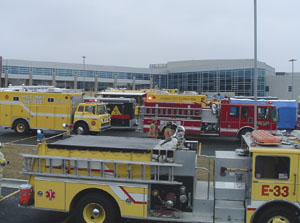Relief Agencies Not Surprised by Kansas City's Response
by David Smale
 In the event of an emergency, the American Red Cross is never far behind the first-responders.
In the event of an emergency, the American Red Cross is never far behind the first-responders.The Homeland Security Division must work in synch with other agencies, like the fire department, city government, hospitals and public health officials. It also is closely tied with the state and federal Depart-ments of Homeland Security.
“We get all the alerts from (the federal) DHS,” Dailey said. “We are closely tied with the Department
of Homeland Security for the state of Missouri. We get alerts from them as well. We have a Mid-America Terrorism Early Warning Group here in Kansas City, Missouri.”
Dailey also said that, even though the department’s response has many common practices, there also are key differences depending on the reason for the crisis.
“In the case of a terrorist attack, you have crime scene responsibilities, suspect responsibilities,” he said. “If it’s an active incident, certainly you have some other issues. But either way, we maintain law and order and protect property and lives. We have the responsibility to control and limit access to the scene of the critical incident. We are responsible for things like traffic control and protection of critical public assets. If there are correlated issues like curfews, we certainly coordinate with state and national law enforcement agencies.”
The American Red Cross is not a first-responder like police and fire. But it is not far behind. “We’re right behind them, providing food, shelter and clothing if needed,” Cope said. “In terms of shelter, we provide a place for them to go. If it’s a small number, usually it would be to local hotels. If it’s a larger number, it might be in a shelter. If they’re in a shelter, we’re feeding them there.”
Cope says the local Red Cross can handle the support effort for up to 72 hours. After that, they rely on help from nearby Red Cross offices as well as the national office. “Just like now, we’re sending people out to the Gulf Coast region to help out efforts there,” he said. “We’re good to support it on our own for a short period and there’s other relief that would come in if it looks like it would be too huge for us.”
The Mid-America Regional Council is a planning organization. The Council’s role is limited during the actual crisis, but it takes a central role before and after. It works through several committees to help agencies set up protocols for an actual crisis. Then, according to Lynch, MARC facilitates the debriefing of lessons learned from previous crises.
“The intent of MARC is to focus on issues that cross state lines and other boundaries, so that local governments can come and work together to develop solutions,” Lynch said. Some of the service-related committees that MARC coordinates are the Mid-America Regional Council Emergency Rescue Committee (ambulance providers), the Local Emergency Preparedness Committee (fire departments, hazardous materials facilities and hospitals), the Metropolitan Emergency Managers Committee, and the Regional Homeland Security Coordinating Committee (leadership from all the disciplines that would be involved in a crisis).
Likewise, Shawnee County Emergency Management coordinates local efforts in eastern Kansas. “We provide coordination of all local resources, whether they’re government or non-government, in the four phases of emergency management: mitigation, preparedness, response and recovery,” Middleton said.
“We work with charitable organizations like the Red Cross and the Salvation Army, plus other local charities like United Way and Let’s Help. We work with Business Continuity Planning Forum, which is a group of business emergency planners in Shawnee County. We work with our local responders: law enforcement, fire department, medical facilities and public works. We are in close contact with our state office of Emergency Management.
“I make the analogy of a musical conductor. We don’t play the music, but we make sure that everybody is working off the same sheet of music.”
The Emergency Operations Center in Kansas City looks like a network television control room. There are six “pods,” each with six work stations, for police, fire, infrastructure (parks and recreation, water services, and public works), flood monitoring, administrative functions, and health and medical services. During an emergency, representatives of these groups come to the EOC to coordinate rescue, relief and recovery efforts.